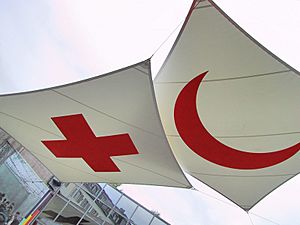Seville Agreement facts for kids
The Seville Agreement is an important plan made by the International Red Cross and Red Crescent Movement. It was created in 1997. This agreement helps decide which part of the Red Cross and Red Crescent family should lead when help is needed. Its full name explains it well: Agreement on the organization of the international activities of the components of the International Red Cross and Red Crescent Movement.
Contents
Why the Seville Agreement Was Needed
The Seville Agreement was not the first plan of its kind. Before 1997, there were other agreements made in 1969, 1974, and 1989. These plans were like "peace treaties" to help different parts of the Red Cross and Red Crescent family work together smoothly. They aimed to prevent disagreements over who should do what. The main groups involved were the International Committee of the Red Cross (ICRC) and the International Federation of Red Cross and Red Crescent Societies (IFRC).
How the Agreement Works
The Seville Agreement clearly explained who takes charge in different situations.
- The ICRC leads when people are in danger because of armed conflict or fighting within a country. They also manage the first effects of natural disasters or refugee situations that happen during a war.
- The IFRC takes the lead during natural disasters. This happens especially when a country's own Red Cross or Red Crescent society needs a lot of help.
- The National Societies (like the American Red Cross) lead in their own countries. This happens when both the ICRC and IFRC agree that the National Society can handle the situation.
Making the Agreement Stronger in 2005
In 2005, the Seville Agreement was improved. New "supplementary measures" were added to make it even better. These measures helped make the roles of the "lead agency" and the local National Society clearer.
The new rules said that the local National Society should always keep its important role. It should be the main partner for the lead agency. All other groups helping in an international operation should support the local National Society. They should help it take a bigger role in guiding and organizing activities.
Also, the role of a "lead agency" was defined as a temporary job. It is only for a specific emergency. The new measures also encouraged everyone in the Red Cross and Red Crescent Movement to learn more about the agreement. The ICRC and IFRC were asked to create training programs. These programs would teach staff and volunteers about the agreement.
Seville Agreement 2.0 in 2022
In 2022, a new version called Seville Agreement 2.0 was created. This new agreement replaced the original 1997 agreement and its 2005 improvements.
Seville 2.0 brought a big change. It now says that the local Red Cross and Red Crescent organizations are the main leaders. They lead the response in their own countries when natural or human-made disasters happen. If a disaster needs help from the whole Movement, the local National Society "convenes" (calls everyone together). The IFRC and/or the ICRC then act as "co-conveners." The IFRC co-convenes for natural disasters, and the ICRC co-convenes for armed conflicts.
See also
 In Spanish: Acuerdo de Sevilla para niños
In Spanish: Acuerdo de Sevilla para niños


